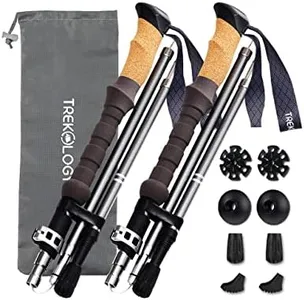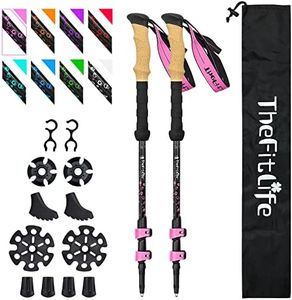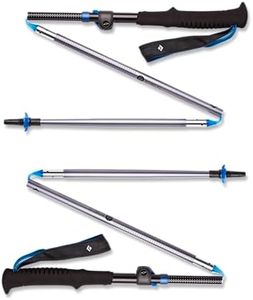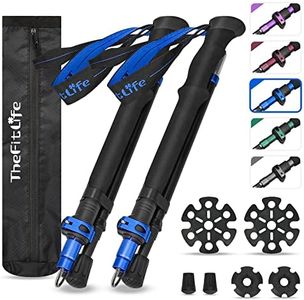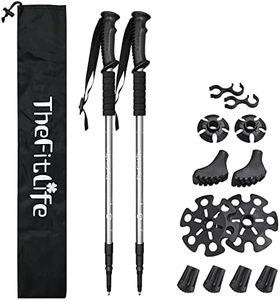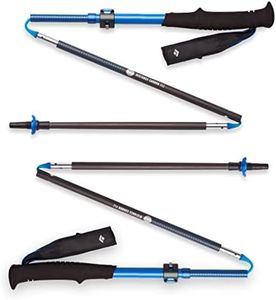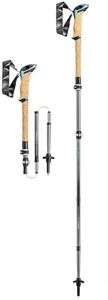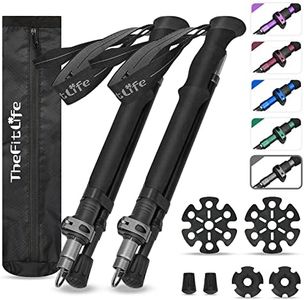We Use CookiesWe use cookies to enhance the security, performance,
functionality and for analytical and promotional activities. By continuing to browse this site you
are agreeing to our privacy policy
10 Best Walking Poles Sticks
From leading brands and best sellers available on the web.Buying Guide for the Best Walking Poles Sticks
Walking poles or sticks can make a big difference to your comfort, balance, and endurance when hiking, trekking, or walking on uneven ground. Choosing the right walking poles means considering how and where you'll use them, your own height, and your personal comfort preferences. The right selection helps prevent fatigue, reduces impact on your joints, and gives you extra stability, especially on tricky terrain.Pole MaterialThe material used for walking poles affects their weight, durability, and flexibility. Common options include aluminum and carbon fiber. Aluminum poles tend to be sturdy and cope well with knocks or bends, so they're great if you expect to use your poles on rocky or rough trails. Carbon fiber poles are lighter, which can make them easier to carry, but they're usually less resistant to heavy impacts. If you want a strong, reliable pole for demanding terrain, aluminum is ideal, while carbon is best for those prioritizing lightness for longer treks.
AdjustabilityAdjustable walking poles allow users to change the length to suit their height and the type of terrain. Some models offer fixed length, which can be lighter but less versatile. Adjustable poles are helpful if you share them with others or if your walking terrain changes—longer for downhill sections and shorter for climbs. If you expect to walk on varied terrain or want flexibility, choose adjustable poles. If you desire minimal weight and always hike on similar ground, fixed length might be sufficient.
Grip TypeThe handles or grips on walking poles can be made from materials like cork, foam, or rubber, each providing different benefits. Cork grips adapt to your hand’s shape over time and absorb some sweat, making them comfortable for long walks. Foam offers a soft feel and excellent sweat absorption, while rubber grips provide insulation and extra grip in cold or wet conditions but can cause sweaty palms in hot weather. Choose a grip material based on your hand comfort, the climate where you walk, and how much you value sweat absorption or insulation.
WeightThe weight of walking poles impacts how easy they are to carry, especially on long walks. Lighter poles are easier to swing and less tiring over time, but sometimes sacrifice a bit of sturdiness. Heavier poles may offer more stability and generally have a longer life but might be tiresome during intensive use. If you’re planning long treks or value ease of use, choose lighter poles. For rough and challenging terrain, a bit more weight can be a worthwhile trade-off for strength.
Locking MechanismMany adjustable poles use locking mechanisms to set and hold the chosen length. There are twist locks, lever locks, and button locks. Lever locks are generally easier and quicker to adjust, even with gloves. Twist locks can be less intuitive and harder to use if your hands are cold or wet. If ease of adjustment is important to you, especially in variable conditions, consider poles with lever or button locks. If you'll rarely adjust your poles, any reliable mechanism will do.
Pole TipsThe tips of walking poles are what make contact with the ground, and they come in materials like carbide or rubber. Carbide tips are tough, grip well on natural surfaces, and are great for most trails. Rubber tips can be added over carbide for pavement or delicate environments to reduce noise and protect surfaces. Think about where you will use your poles most—if it’s on trails, stick with standard carbide; for city walks or delicate surfaces, make sure you can add or swap for rubber tips.
Shock AbsorptionSome walking poles feature built-in shock-absorbing systems, usually springs inside the shaft. These systems help reduce impact, which can be particularly helpful for people with sensitive joints or those doing lots of downhill walking. Shock-absorption can add a bit of weight and may feel less ‘direct’ for technical climbing. If you have knee or joint pain, or walk a lot on hard surfaces, look for poles with this feature. For those who want a more connected feel to the ground, or lighter poles, standard versions without shock absorption may be preferable.
